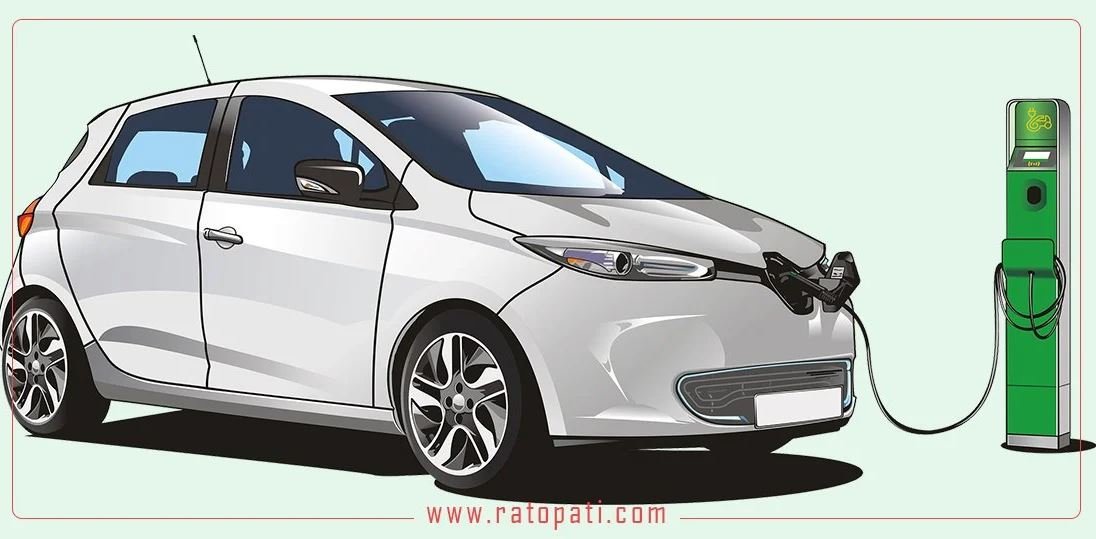Electric Vehicles' Future in Nepal

Most Nepalese buyers believe that an electric vehicle will be ready by 2023, but the majority also believe that it will no longer be available until 2025. Consumers in Nepal are looking for a lower price for EVs than those in other countries, with the global average tipping price for EVs being $36,000. (Around Rs 45lakh). The cost of lithium-ion batteries is roughly $250/kWh globally, which translates to approximately Rs 9.5 lakh in battery prices alone. Currently, lithium-ion batteries account for half of the cost of an electric vehicle, making them more expensive than conventional Vehicles. The safety of the batteries against explosion serves as a stumbling block for Li-ion batteries. Charging is a significant barrier for EVs in Nepal, and a lack of charging stations may also be considered, rendering them impracticable or significantly less feasible for long-distance rides. Furthermore, some EVs are slower than standard gas-powered engines. At a critical moment, as many nations are working to free Mother Earth from the clutches of carbon emissions and CO2, Nepal should take the lead by transitioning to EV mobility, making the country a greener and cleaner ecosystem.
Electric Vehicle Market in Nepal
The Indian automobile industry is the world’s fifth biggest, and it is anticipated to become the third largest by 2030, likely Chinese companies are also the biggest manufacturing EVs companies in the world. According to the India Energy Storage Alliance (IESA), the Indian EV market would develop at a 36% CAGR.
As India’s population grows and demand for automobiles increases, reliance on conventional energy supplies is no longer a viable option, as the country imports over 80% of its crude oil. Over the past two years, the Nepali electric vehicle (EV) market has witnessed a remarkable growth trajectory. Official data shows a substantial increase in the import of EVs in the passenger vehicle segment as 4,050 units of such vehicles worth Rs 11.83 billion were imported in the last fiscal year 2022/23 compared to 1,807 in FY 2021/22 and a mere 200 units in FY 2020/21. The EV import figure in the last fiscal year is a staggering 124.12 percent increase from FY 2021/22. The Indian electric vehicle market was worth USD 1,434.04 million in 2021, and it is predicted to grow to USD 15,397.19 million by 2027, at a CAGR of 47.09% during the forecast period (2022-2027). The automobile import data of the last fiscal year suggests that EVs accounted for 50 percent of passenger vehicle sales underscoring the popularity and potential of EVs in the country. As the Nepali automotive business traverses through various ups and downs stemming from changes in policy directions of the government and the central bank as well as the market grappling with economic uncertainties, the EV business has become a new sunrise sector that is fueled by innovations and disruptions the world over. The annual foreign trade statistics issued by the Department of Customs show Nepal imported electric cars and SUVs mainly from six countries, namely India, China, South Korea, the United States, the United Kingdom, and Indonesia. In FY2022/23 India topped the list of EV source countries for Nepal. Nepal imported 2277 units of electric vehicles from its southern neighbor. Similarly, the country imported 1371 electric vehicles from China. Nepali automobile dealers have been importing EVs of US brand Tesla, European brands Audi, Jaguar, MG (now Chinese owned), Citroen and Peugeot, Korean brands Hyundai and Kia, Japanese brand Nissan, Chinese brands BYD, Great Wall Motors, and Indian brand Tata.
Drawbacks of Transition to Electric Vehicles
The following problems must be addressed if we are to transition to EVs by 2030, as promised by the Government:
• Electric vehicle charging infrastructure.
• Higher Costs
• Lack of a Skilled Workforce
• Limited Technology
• Import of electric vehicle components and materials
The government’s own policy of increasing electricity consumption and moving towards zero carbon emissions. “The government’s approach to reducing taxes on mid-range EVs while increasing taxes on entry-level vehicles seems counter-intuitive. Entry-level electric vehicles are often more affordable and accessible to a wider range of consumers, which could have encouraged more people to adopt green vehicles and contribute to reducing carbon emissions,” he said, adding, “By imposing higher taxes on the very segment of electric vehicles that is in high demand and actively being used in Nepal, the government risks deterring potential buyers and hindering the growth of the EV market.”
Electric vehicle charging infrastructure
In the current circumstance, if a person needs to go a long distance because his e-vehicle has a low charge. His options for recharging are quite limited. In India, there are around 70,000 filling stations spread among 718 districts. A gas station may be found every 5-6 kilometers. On the other side, there are only 300 electric vehicle charging outlets. A person driving an electric car will have a difficult voyage in such a circumstance. The government is taking measures to address this issue, but the pace is slow. As of 2022, Nepal has an estimated 25 public EV charging stations installed across the country, according to data from the Nepal Electricity Authority (NEA). Most of the current charging points gather in the Kathmandu Valley, and you can find a few stations in places like Pokhara, Chitwan, Birgunj, and some other big cities.
Higher Costs
Let’s say a person wishes to buy a medium automobile in India, such as a Maruti Suzuki Swift. The vehicle’s on-road pricing in the fuel form is 6-7 lakhs. Tesla’s electric automobile, on the other hand, begins at 60 lakhs in India. India is a price-sensitive market, and the transition to e-vehicles would be sustainable only if it is inexpensive. In Nepal too, people are searching for the best electric cars, whether they are buying new or switching from fossil-fueled to electric cars. There are some absolute best electric cars available currently and new and improved electric cars are getting available in the near future in Nepal. So, here we have a list of the eight best electric cars in Nepal as of January 2023.
| S. N | Models | Price |
| 1 | Neta V | Rs 3,799,000 |
| 2 | TATA Nexon EV XM– | Rs 3,899,000 |
| TATA Nexon EV XZ+ | Rs 4,099,000 | |
| TATA Nexon EV XZ + Lux | Rs 4,299,000 | |
| 3 | BYD ALL-NEW E6 | Rs 5,900,000 |
| 4 | Hyundai Kona EV NS | Rs 6,096,000 |
| GL 100 KW | Rs 6,196,000 | |
| GLS 100 KW | Rs 6,456,000 | |
| 5 | Nissan Leaf | Rs 6,499,000 |
| 6 | Kia Niro EV | Rs 6,990,000 |
| 7 | MG ZS EV | Rs 8,199,000 |
| 8 | Hyundai Iqoniq 5 | Rs 11,696,000 |
Lack of a Skilled Workforce
In terms of electric cars, India has a trained labor shortage. The technology is new, and prominent educational institutions are unable to adapt to the world’s developing EV technology.
Limited Technology. India has a major technological dilemma. A typical Maruti Suzuki Swift Petrol vehicle has a fuel tank capacity of 40 liters. The automobile can travel up to 600 kilometers if the mileage is 15 km per liter. Similarly, in terms of technology, will a totally charged car go the same distance? Ather is a well-known EV manufacturer in India. According to the business, it can travel up to 120 kilometers on Nepalese roads on a full charge.
Import of electric vehicle components and materials
Due to a lack of technology, India must import the majority of e-vehicle supplies. The battery of an EV is quite important. At the moment, all batteries use Lithium-Ion technology. India’s lithium reserves are uncertain. As a result, India must import the majority of battery and EV electrical components from China, resulting in India’s strategic reliance on China. There may be more pain than gain for EV makers and buyers from the Union Budget 2023-24. While the Finance Minister did extend the customs duty exemption for capital goods and machinery for lithium-ion manufacturing for EVs, she did make importing auto parts costlier for all automobiles. The net effect may be that EVs might become costlier going ahead. Customs duty on electrically operated vehicles in completely built units (CBUs) form, other than with cost, insurance and freight (CIF) value of more than $40,000 (approx. ₹32.76 lakh), has been raised to 70% from 60%. To reduce dependency and boost local manufacturing, the basic customs duty (BCD) on vehicles (including electric vehicles) in the Semi-Knocked Down (SKD) form also increased from 30% to 35%.
Conclusion
The future of electric vehicles is bright and shining! Manufacturing businesses are putting more effort into transitioning from traditional automobiles to electric vehicles. There are several advantages to owning an electric car with the appropriate level of functionality and infrastructure. So, it is not only better for the environment but also for the profit of public transportation. Furthermore, Nepal is capable of developing an infrastructure on its own, so that the ecosystem of private two-wheeler EVs, private four-wheeler EVs as well as large and small public EVs, operate in harmony.


Leave Comment